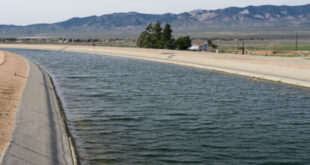The initial 2020 State Water Project (SWP) allocation was announced Monday by the California Department of Water Resources (DWR). DWR’s allocations are based on conservative assumptions and may change depending on rain and snow received throughout the winter. The state’s initial allocation is set intentionally low so as to guard against problems occurring if precipitation in the form of both snow and water fail to continue materializing throughout the winter and early spring.
Allocations are based on several factors, including conservative dry hydrology, reservoir storage, and releases necessary to meet water supply and environmental demands. With these factors in mind the DWR’s announcement on Monday was for 10 percent for the initial SWP allocations.
“We are thankful for the recent rains and the start of the new water year with above average reservoir storage, but the dry start in October and November reminds us that California’s weather is extremely variable and we must prepare for various conditions,” said DWR Director Karla Nemeth. “The wet weather can stop from one day to the next.”
DWR’s initial allocation for 2019 was not made until late February 2019 and ranged from 35 percent of their contract supply for agricultural water service contractors South-of-Delta versus 100 percent of their contract total for Eastside water service contractors (Central San Joaquin Water Conservation District and Stockton East Water District). Updates to SWP allocations were announced multiple times in the first half of 2019 ranging from the initial February announcement up until the final allocation announcement was announced in mid-June of this year.
San Luis Reservoir, the largest off-stream reservoir in the United States where water is stored for the SWP and the Central Valley Project (CVP), is at 43 percent of capacity and 72 percent of average. Lake Oroville, the SWP’s largest reservoir, is currently at 54 percent of capacity and 90 percent of average for this time of year. Shasta Lake, the CVP’s largest reservoir, is at 71 percent of capacity and 119 percent of average. To the far south, SWP’s Castaic Lake is at 77 percent of capacity and 101 percent of average.
The season’s first snow survey at Phillips Station in the Sierra Nevada will be conducted by DWR on January 2, 2020. On average, the snowpack supplies about 30 percent of California’s water needs as it melts in the spring and early summer. Nearly all areas served by the SWP have other sources of water than just the SWP allocation, such as streams, groundwater, and local reservoirs. The SWP provides water to 29 SWP contractors who supply water to 750,000 acres of farmland and more than 27 million Californians.
Additional rain is predicted for both northern and southern California this week and could be heavy in certain areas. The possibility also exists for an atmospheric steam in mid-state. For additional information on current water conditions at the state’s largest reservoirs and weather stations, visit the California Data Exchange Center (CDEC) at: http://cdec.water.ca.gov/.
 California Water News Daily Your Source For Water News in California
California Water News Daily Your Source For Water News in California


